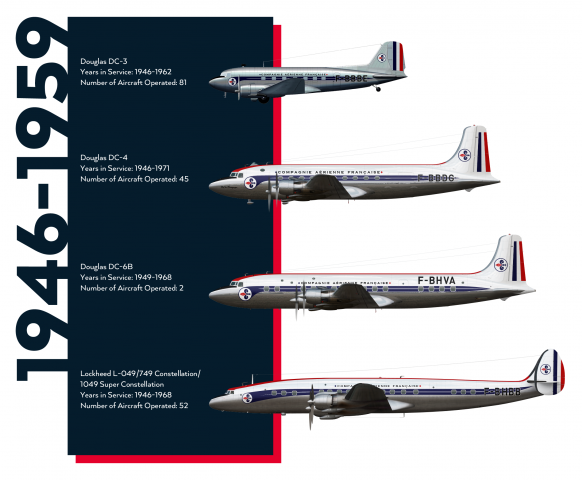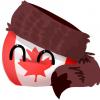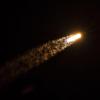
Formation and early years
- Owner: Avelo (View all images and albums)
- Uploaded: Jun 09 2021 06:58 PM
- Views: 1,409
- Album CAF French Airlines

CAF's 1940s-1950s fleet
Amiot AAC.1 Toucan (Junkers Ju 52/3m)*
Bréguet 763 Deux-Ponts*
de Havilland Comet*
Douglas DC-3
Douglas DC-4
Douglas DC-6B
Latécoère 631*
Lockheed L-049/749 Constellation*
Lockheed L-1049 Super Constellation
Lockheed L-1649A Starliner*
SNCASE SE.161 Languedoc*
*not shown in image due to absence of templates
CAF – Compagnie Aérienne Française was established on 7 October 1933 as an amalgamation from the merger of Air Orient, Air Union, Compagnie Générale Aéropostale, Compagnie Internationale de Navigation Aérienne (CIDNA) and Société Générale des Transports Aériens (SGTA). Of these airlines, SGTA was the first commercial airline company in France, having been founded as Lignes Aériennes Farman in 1919. The constituent members of CAF had already built extensive networks across Europe, to French colonies in North Africa and farther afield. During World War II, CAF moved its operations to Casablanca (Morocco).
In 1936, CAF added French-built twin engine Potez 62 aircraft to its fleet featuring a two-compartment cabin that could accommodate 14 to 16 passengers. A high wing monoplane, it had a wooden fuselage with composite coating while the wings were fabric covered with a metal leading edge. Equipped with Hispano-Suiza V-engines, they were used on routes in Europe, South America, and the Far East. Although cruising at only 175 miles per hour, the Potez 62 was a robust and reliable workhorse for CAF and remained in service until the Second World War with one used by the Free French Air Force.
On 26 June 1945, all of France's air transport companies were nationalized, and on 29 December a decree of the French Government granted CAF the management of the entire French air transport network. CAF appointed its first flight attendants in 1946, and that same year the airline opened its first air terminal at Les Invalides in central Paris. It would be linked to Paris’s Le Bourget Airport, CAF's first operations and engineering base, via coach buses. At that time, CAF’s route network covered a total distance of 160,000 km across all six inhabited continents.
European schedules were initially operated by a fleet of Douglas DC-3 aircraft. On 1 July 1946, CAF started direct flights between Paris and New York via refuelling stops at Shannon and Gander. Douglas DC-4 piston-engine airliners covered the route in just under 20 hours. In September 1947, CAF's network stretched east from New York, Fort-de-France, and Buenos Aires to Shanghai.
By 1948 CAF operated 130 aircraft, one of the largest fleets in the world at the time. Between 1947 and 1965 the airline operated Lockheed Constellations on passenger and cargo services worldwide.
CAF underwent a reorganisation by act of parliament on 16 June 1948. Initially, the government held a 70% stake in the airline, though in subsequent years, the French state's direct and indirect shareholdings would reach almost 100%.
On 4 August 1948 Max Hymans was appointed as president of CAF. During his 13-year tenure he would implement modernisation practices centred on the introduction of jet aircraft. In 1949 the company became a co-founder of Société Internationale de Télécommunications Aéronautiques (SITA), an airline telecommunications services company.
In 1952 CAF moved its operations and engineering base to the new Orly Airport South terminal, and the following year the airline entered the jet age in 1953 with the original but short-lived de Havilland Comet series 1, the world's first jetliner. During the mid-1950s CAF also operated the Vickers Viscount turboprop, with 12 entering services between May 1953 and August 1954 on European routes.
This looks great! that DC-3 is amazing
Oh my god. 81 DC-3s?? Wow!
Oh my god. 81 DC-3s?? Wow!
This was actually the total number of DC-3s Air France operated over the entire period the type has flown with the airline, just to let you know. Many of those planes probably got retired and replaced by newer airframes over that span ![]()
For reference: https://en.wikipedia...ir_France_fleet
Competition for Avion? Interesting.
This was actually the total number of DC-3s Air France operated over the entire period the type has flown with the airline, just to let you know. Many of those planes probably got retired and replaced by newer airframes over that span
For reference: https://en.wikipedia...ir_France_fleet
Seriously? That's crazy
Oh my god. 81 DC-3s?? Wow!
This was actually the total number of DC-3s Air France operated over the entire period the type has flown with the airline, just to let you know. Many of those planes probably got retired and replaced by newer airframes over that span
Competition for Avion? Interesting.
Oh boy I’ve got competition, we shall see how this turns out

 Sign In
Sign In Create Account
Create Account
















This looks great! that DC-3 is amazing